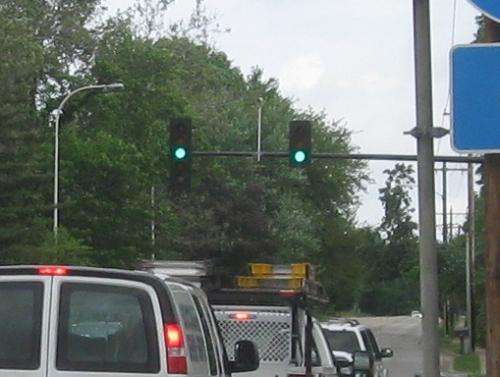May 22, 2013 feature
Physics of 'green waves' could make city traffic flow more smoothly

(Phys.org) —If you've been lucky enough to catch all the green lights as you drive down a busy street, you may have been benefiting from intentional synchronization called a "green wave." The green wave concept has been around in the US since the 1920s, but it doesn't always work as it should. When traffic gets backed up for some reason, "green wave breakdown" occurs. In a new paper, physicist Boris Kerner at the University of Duisburg-Essen in Essen, Germany, has modeled and analyzed the causes of green wave breakdown, and the results may lead to better coordinated green waves and more efficient traffic flow.
Kerner's paper, "The physics of green-wave breakdown in a city," is published in a recent issue of EPL.
Many large cities around the world, especially in Europe and the US, synchronize traffic lights on the busiest streets to create green waves. When a green wave works as intended, all vehicles within the wave can drive through a sequence of green traffic lights at a certain speed without having to stop at the signals. The timing of the lights can be controlled either by sensors or timers, and can be set up for traffic in one direction or both directions. Green waves have several benefits, such as allowing for higher traffic loads, reducing traffic jams, controlling traffic speed, reducing fuel consumption and emissions, and facilitating bicycle and pedestrian traffic.
The biggest disadvantage of green waves is that, when the wave is disturbed, the disturbance can cause traffic problems that can be exacerbated by the synchronization. In such cases, the queue of vehicles in a green wave grows in size until it becomes too large and some of the vehicles cannot reach the green lights in time and must stop. This is called over-saturation. As more and more vehicles stop, the traffic can cause a gridlock where vehicles can't move forward even when the light turns green because vehicles are backed up at the light ahead, which may still be red or turning green at the same time.
The physics of this green wave breakdown has not been thoroughly studied until now. In his paper, Kerner used two kinds of models to investigate the underlying mechanisms. He identified several general features of green wave breakdown that are independent of the traffic flow model used, and also discovered that the physical characteristics of green wave breakdown depend crucially on which model is used.
In one model, called a three-phase model, green wave breakdown occurs due to an initial speed disturbance (for example, a car turning onto the main road from a side street) that causes a moving synchronized flow pattern (MSP). In an MSP, vehicles move slower than in the initial free flow of green wave, causing delays that destroy the green wave synchronization with the traffic lights. The result is oversaturated traffic at the traffic signals.
In the other model, called a two-phase model, an initial speed disturbance does not cause an MSP and the delays associated with MSPs. However, if the initial speed disturbance is large enough, and there is a large number of vehicles in the wave, then oversaturation and green wave breakdown can still occur.
In both models, Kerner found that one or more phase transitions are involved in the breakdown process. Also, breakdown occurs with a certain probability of less than 1; in simulations runs with the same parameters, breakdown occurs at some times but not at others.
While the models offer a theoretical explanation of how green wave breakdown may occur, experimental tests are needed to gather data and determine which model best fits the data. Kerner hopes that an empirical test will be performed in which the vehicle speed and flow rate are measured both upstream and downstream of a synchronized traffic signal. By studying speed disturbances and the possible emergence of MSPs, researchers could then determine the initial disturbances and how they lead to green wave breakdown.
"This would be a very interesting test for an EU project," Kerner told Phys.org. "However, as far as I know, there are no EU programs for such empirical studies of signal control. The problem is that my theory contradicts all classical theories of urban traffic, which, as is well known, do not work in the real world."
More information: Boris S. Kerner. "The physics of green-wave breakdown in a city." EPL, 102 (2013) 28010. DOI: 10.1209/0295-5075/102/28010
Journal information: Europhysics Letters (EPL)
© 2013 Phys.org. All rights reserved.




















